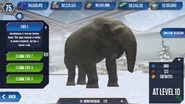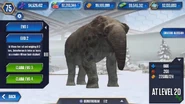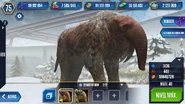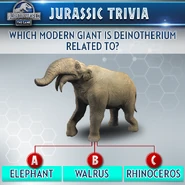(quick fix of these things: ") |
(Adding categories) |
||
| (23 intermediate revisions by 8 users not shown) | |||
| Line 1: | Line 1: | ||
| − | {{Dinosaur|meaning = Terrible Beast|diet = Herbivore|length = 7 meters (22.9 feet)|height = 3.5-4.5 meters (11.5-14.8 feet)|weight = (8.8-14.3 tons) (17,636 lbs-28,660 lbs) (8,000-13,000 kg)|range = Africa<br>Asia<br>Europe|birth type = Live Birth|game = ''[[Jurassic World: The Game]]''|image = |
+ | {{Dinosaur|meaning = Terrible Beast|diet = Herbivore|length = 7 meters (22.9 feet)|height = 3.5-4.5 meters (11.5-14.8 feet)|weight = (8.8-14.3 tons) (17,636 lbs-28,660 lbs) (8,000-13,000 kg)|range = Africa<br>Asia<br>Europe|birth type = Live Birth|game = ''[[Jurassic World: The Game]]''|image = Deinotherium_New_Card.png}}'''''{{W|Deinotherium}}''''' ("terrible beast") was a large prehistoric relative of modern-day elephants that appeared in the Middle Miocene and survived until the Early Pleistocene. During that time it changed very little. In life, it probably resembled modern elephants, except it had downward curving tusks attached to the lower jaw. The way ''Deinotherium'' used its curious tusks has been much debated. It may have rooted in soil for underground plant parts like roots and tubers, pulled down branches to snap them and reach leaves, or stripped soft bark from tree trunks. ''Deinotherium'' fossils have been uncovered at several of the African sites where remains of prehistoric hominid relatives of modern humans have also been found. Early Pleistocene species of ''Deinotherium'' might have also fallen prey to ''[https://en.wikipedia.org/wiki/Homotherium Homotherium]'', particularly adolescents and calves |
Three species are recognized, all of great size. ''Deinotherium giganteum'' is the type species, and is described above. ''Deinotherium'' was a large proboscidean. Two adults of ''D. giganteum'' are around 3.63–4 metres (11.9–13.1 ft) tall and weight 8.8–12 tonnes (8.7–11.8 long tons; 9.7–13.2 short tons). This is similar to adult males of ''D. proavum'', one of which weighted 10.3 tonnes (10.1 long tons; 11.4 short tons) and was 3.59 metres (11.8 ft) tall. However, both these species are smaller than a 45-year-old male of ''D. "thraceiensis"'', at 4.01 metres (13.2 ft) tall and 13.2 tonnes (13.0 long tons; 14.6 short tons) in weight. |
Three species are recognized, all of great size. ''Deinotherium giganteum'' is the type species, and is described above. ''Deinotherium'' was a large proboscidean. Two adults of ''D. giganteum'' are around 3.63–4 metres (11.9–13.1 ft) tall and weight 8.8–12 tonnes (8.7–11.8 long tons; 9.7–13.2 short tons). This is similar to adult males of ''D. proavum'', one of which weighted 10.3 tonnes (10.1 long tons; 11.4 short tons) and was 3.59 metres (11.8 ft) tall. However, both these species are smaller than a 45-year-old male of ''D. "thraceiensis"'', at 4.01 metres (13.2 ft) tall and 13.2 tonnes (13.0 long tons; 14.6 short tons) in weight. |
||
| Line 25: | Line 25: | ||
==Trivia== |
==Trivia== |
||
*In reality, ''Deinotherium'' most likely had a longer trunk than how it's portrayed in ''Jurassic World: The Game'', to better help it in drinking. |
*In reality, ''Deinotherium'' most likely had a longer trunk than how it's portrayed in ''Jurassic World: The Game'', to better help it in drinking. |
||
| + | |||
| − | *In reality, "Deinotherium" lived in a warm Savannah climate, and probably would of died of Hypothermia if left in a cold, snow filled enclousure. |
||
| + | ==Navigation== |
||
| + | {{SpeciesNavBox}} |
||
[[Category:Cenozoic animals]] |
[[Category:Cenozoic animals]] |
||
[[Category:Mammals]] |
[[Category:Mammals]] |
||
[[Category:Proboscidea]] |
[[Category:Proboscidea]] |
||
| + | [[Category:Mammals of Africa]] |
||
| + | [[Category:Miocene animals]] |
||
| + | [[Category:Pliocene animals]] |
||
| + | [[Category:Pleistocene animals]] |
||
| + | [[Category:Mammals of Asia]] |
||
| + | [[Category:Mammals of Europe]] |
||
| + | [[Category:Other Animals Discovered in the 1820s]] |
||
Revision as of 19:27, 10 May 2020
Deinotherium ("terrible beast") was a large prehistoric relative of modern-day elephants that appeared in the Middle Miocene and survived until the Early Pleistocene. During that time it changed very little. In life, it probably resembled modern elephants, except it had downward curving tusks attached to the lower jaw. The way Deinotherium used its curious tusks has been much debated. It may have rooted in soil for underground plant parts like roots and tubers, pulled down branches to snap them and reach leaves, or stripped soft bark from tree trunks. Deinotherium fossils have been uncovered at several of the African sites where remains of prehistoric hominid relatives of modern humans have also been found. Early Pleistocene species of Deinotherium might have also fallen prey to Homotherium, particularly adolescents and calves
Three species are recognized, all of great size. Deinotherium giganteum is the type species, and is described above. Deinotherium was a large proboscidean. Two adults of D. giganteum are around 3.63–4 metres (11.9–13.1 ft) tall and weight 8.8–12 tonnes (8.7–11.8 long tons; 9.7–13.2 short tons). This is similar to adult males of D. proavum, one of which weighted 10.3 tonnes (10.1 long tons; 11.4 short tons) and was 3.59 metres (11.8 ft) tall. However, both these species are smaller than a 45-year-old male of D. "thraceiensis", at 4.01 metres (13.2 ft) tall and 13.2 tonnes (13.0 long tons; 14.6 short tons) in weight.
| Wikipedia has a more detailed and comprehensive article on Deinotherium |
Jurassic Park franchise
Jurassic World: The Game
On October 26, 2017, Deinotherium was added as a legendary Cenozoic snow creature.
Trivia
- In reality, Deinotherium most likely had a longer trunk than how it's portrayed in Jurassic World: The Game, to better help it in drinking.






